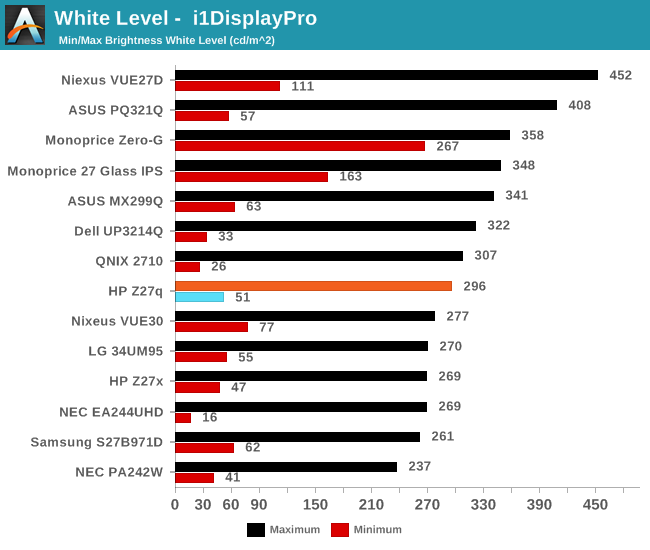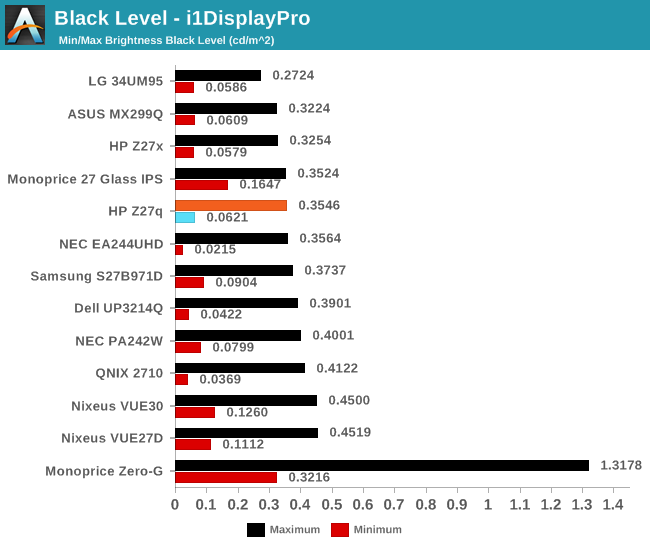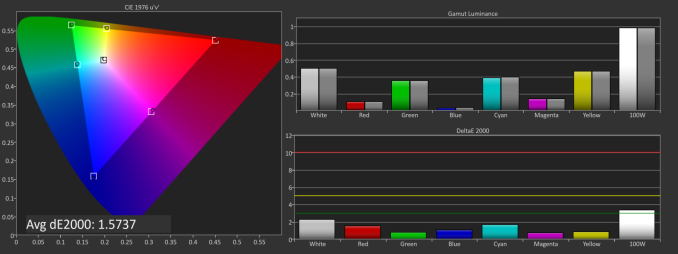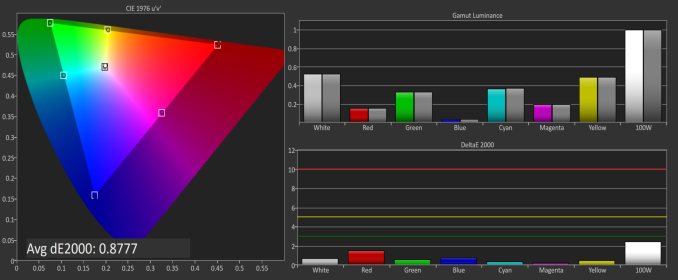HP Z27q Monitor Review: Aiming For More Pixels
by Brett Howse on December 22, 2015 8:00 AM ESTContrast and Brightness
Monitors for desktops don’t need the very high brightness of a tablet or smartphone, since they are used indoors. HP rates the Z27q as a 300 cd/m2 display, and I was able to hit almost exactly that at 296 cd/m2 which is plenty for indoor use. Minimum brightness was 50 cd/m2 so there is quite a bit of dynamic range there to find a suitable brightness for pretty much any office space.

Black levels are pretty consistent with IPS desktop panels, but overall they are a bit too high. Techniques like photo-aligning the backlight and panel can bring some big gains in black levels, but HP is not using such a panel. As such, the overall black levels are less than amazing. Contrast is ultimately not as important as proper gamma for this type of display, but still it would be nice to see better in expensive desktop panels at this point since the technology is available.

This gives us a pretty paltry contrast ratio of 833:1, which is a long way from the 1800:1 seen in some tablets and notebooks. HP is clearly ok with this performance though since it matches the Z27x almost exactly.

Ultimately even though this is a low price for a 5K monitor, it is still far from inexpensive. This is targeted more towards professionals who are after a better overall gamma curve and color accuracy, and consumers may want to stick to a more traditional panel with better contrast for things like watching movies.
Gamut Options
HP offers the very high gamut Z27x display, but the Z27q trades off that gamut for a higher resolution. Still, it can cover both sRGB and AdobeRGB (as well as Rec. 709) and there are built in options for picking the color gamut. The Z27q has a 14-bit LUT, but it is not user accessible, and is calibrated at the factory. Once dialed in, there is no way to adjust it after the fact, so people who are after the utmost in accuracy will likely have to spend a bit more.
Below you can see the gamut options for the Z27q. The additional gamut of AdobeRGB is easily achieved by this panel.
The built in calibration is quite impressive, with the Z27q nicely matching both the sRGB and AdobeRGB spaces with no issues. Some additional options would be nice though, especially DCI/P3, if only because the gamut is likely covered by this display anyway, but there is no way to set the panel to that range.












92 Comments
View All Comments
petteyg359 - Tuesday, December 22, 2015 - link
Why use software to do what hardware should be doing by giving me multiple screens?DanNeely - Tuesday, December 22, 2015 - link
Has there been any news about LGs 31.5" 5k panel (same height as 30" 1600p models) since the initial announcement in January. At that time, they were expecting panel production in Q3 of this year and initial retail availability around now, but I haven't seen anything since then.http://linustechtips.com/main/topic/289516-lgdispl...
BrokenCrayons - Tuesday, December 22, 2015 - link
It's pretty, but also pretty impractical. I just got an 18.5 inch replacement for my 15 inch monitor and it was hard to find one in that size at 1366x768 which is annoying since high resolutions just require scaling and end up only able to display the same amount of information at a cost of additional computation making the entire higher resolution thing a bit of an exercise in pointlessness. But aside from that, 27 inch screens are far too large for personal computing at a desk, forcing the user to push the screen away from their eyes in order to make effective use of it, once again defeating the purpose of scaling up the display. I'm already experiencing this moving up to an 18.5 inch screen. It's uncomfortable to use at the same distance so it had to move further away until it appears effectively the same size as my previous screen. The larger panel is therefore something of a waste as it's also too small to effectively serve as a conference room display. Overall, I'd say it's a very niche market and highly impractical screen. I'd be surprised if it makes many sales.Spunjji - Tuesday, December 22, 2015 - link
You're not on the side of the average consumer with your comments there, but this is definitely intended to be a niche product.Scaling is still useful, too. Text at the same size but rendered with more pixels is a lot more legible and pictures treated in the same manner look much more natural.
zodiacfml - Thursday, December 24, 2015 - link
5K is essentially for photo or high resolution video work. I have 15inch notebook with 1366x768 resolution and the pixels are pretty big and obvious. I can see it right now in this blue border of this Post your comment box. I have seen a 5K Mac display at close distance and the it reminds me of looking at a smartphone display in terms of PPI/sharpness.chaos215bar2 - Tuesday, December 22, 2015 - link
Is there a technical reason we aren't seeing the 5k equivalent of 30" monitors (5120x3200)? 27" 5k is nice, but this is a computer monitor, not a TV. Until monitors start seriously going beyond 27" (while maintaining pixel density), 16:9 really isn't an ideal aspect ratio for most work.DanNeely - Tuesday, December 22, 2015 - link
16:10 is dead, just as 4:3 died years prior. Being the same resolution as TVs certainly helped; that a 16:9 screen took less material and was therefor cheaper than a 16:10 one with the same diagonal size was probably the final nail in the coffin.theduckofdeath - Wednesday, December 23, 2015 - link
Agreed, 19:10 is for people who still full-screen all their apps, I think. 16:9 is more practical for side by side windows.theduckofdeath - Wednesday, December 23, 2015 - link
-3:p
okashira - Tuesday, December 22, 2015 - link
16 watts in standby? What a POS.